-
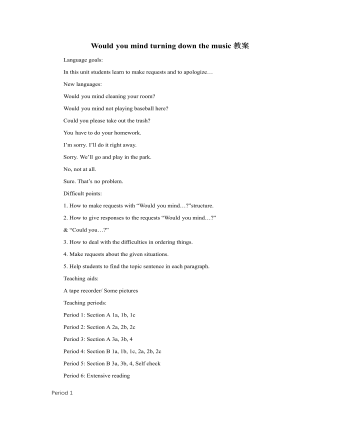
人教版新目标初中英语八年级下册Would you mind turning down the music教案
Step 4. Group work (4)1. Ask a pair of students to read the dialogue. Say, This activity provides speaking, listening and writing practice using the target language.2. Ask students to complete the work in groups.3. Check the answers with the whole class. 4. Explain some of the language points. Step 5. Word review (Self check 1)1. Ask students to read the words and the phrases given. 2. Fill in the blanks with proper forms of these words to complete the sentences. 3. Check the answers with the whole class. Homework:Do activity 2 on page 57 after class. Period 6Teaching aims: 1. Teach vocabulary words and the useful expressions. 2. Enable the students to learn etiquette in different culture. 3. Help the students learn how to behave politely in public places and in daily life. Teaching procedures:Step 1. RevisionHelp students to review the function of making requests through a free talk. Then lead them to the topic of etiquette. Explain the meaning of etiquette. Or, ask students to look it up in the dictionary. Step 2. Pre-reading (Section 1)1. Ask students to read the picture and make a list with their partner about how many rules of etiquette can be seen being broken.
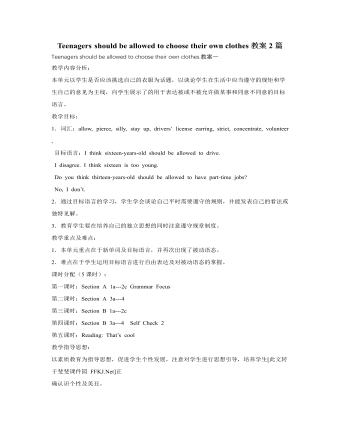
人教版新目标初中英语九年级上册Teenagers should be allowed to choose their own clothes教案2篇
Step 1 Greeting Greet the class and check the homeworkStep 2 A duty report The S on duty gives a report on the rules in his home and lead in 3a “Sun Fei’s and Wu Yu’s rules” Step 3 ReadingSs read the conversation and write the two girls’ rules in the chart. Check the answers.Get Ss to read after the tape and then read aloud by themselves. Then, T explains the language points.Step 4 Pairwork 3bRole play. Use the information in chart to practice with the conversation in 3a covered. They can look at the sample conversation in the right box.Step 5 Task 2 “Who’s the best reporter?”Make a survey by asking any 5 students the questions in the chart in activity 4. Then give out a report about it. See who is the best reporter? And the best reporter will get a nice ball-pen.Step 6 Summary and homework:Write out the report in your exercise-books.Period ThreeStep 1 Greeting and a duty reportThe S gives a duty report talking about his experience of being late for school. Lead in the question “Do you ever get to school late? How often do you get to school late? Always, usually, sometimes, or never?Step 2 1a Get Ss to finish writing.Step 3 Pairwork 1b Get Ss to talk about their answers with their partners using the sample conversation in the box on the right.Step 4 Listening practice2a Lead-in: What will happen if you get to school late? What about Peter? Let’s listen to a conversation between Peter and his father. Get Ss to finish 2a (As usual, for the first time, Ss only listen.) Check the answers.

人教版新目标初中英语九年级上册How do you study for a test教案2篇
内容提示本单元主要内容是学会利用verb十by/with gerund表示方式方法来讨论学习英语的策略,认识自己在学习方面的长处和不足。初步了解现在完成时的结构和用法。现在完成时由助动词have/has+动词的过去分词构成,主要表示过去发生的某一动作对现在仍有影响或造成的后果,常与already,yet,just,ever,never等副词连用。教学目标一、学习目标(Language Goal) 1. Talk about how to study . 学会讨论各种学习方法和策略。2. Find out your suitable learning methods. 找出适合自己的学习方法。 二、语言结构(Language Structures) 1. Verb + by with gerund by+动名词短语 表示“通过…途径,方法” 2. How questions have引导的特殊疑问句 三、目标语言(Target Language) 1. How do you study for tests ? 你是怎样准备考试的?Well , I study by working with my classmates. 哦,我和同学们一起学习。2. Have you ever studied with a group ? 你曾经参加过学习小组吗?Yes , I have . I’ve learned a lot that way . 是的,参加过。通过这种方式我学了许多。
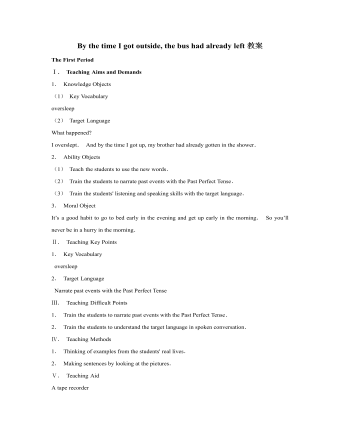
人教版新目标初中英语九年级下册By the time I got outside, the bus had already left教案
Ⅰ. Teaching Aims and Demands1. Knowledge Objects(1) Key Vocabularyoversleep(2) Target LanguageWhat happened?I overslept. And by the time I got up, my brother had already gotten in the shower.2. Ability Objects(1) Teach the students to use the new words.(2) Train the students to narrate past events with the Past Perfect Tense.(3) Train the students' listening and speaking skills with the target language.3. Moral ObjectIt’s a good habit to go to bed early in the evening and get up early in the morning. So you’ll never be in a hurry in the morning.Ⅱ. Teaching Key Points1. Key Vocabularyoversleep2. Target LanguageNarrate past events with the Past Perfect TenseⅢ. Teaching Difficult Points1. Train the students to narrate past events with the Past Perfect Tense.2. Train the students to understand the target language in spoken conversation.Ⅳ. Teaching Methods1. Thinking of examples from the students' real lives.2. Making sentences by looking at the pictures.Ⅴ. Teaching AidA tape recorderⅥ. Teaching ProceduresStep I Revision1. Revise the language points in Unit 8.Ask some questions like this: What volunteer work would you like to do?Help the students to answer, I’d like to…/I love to…/I hope to2. Practice the dialogue in Activity 3c on page 62 again. Get students to role play the similar dialogues with the following.
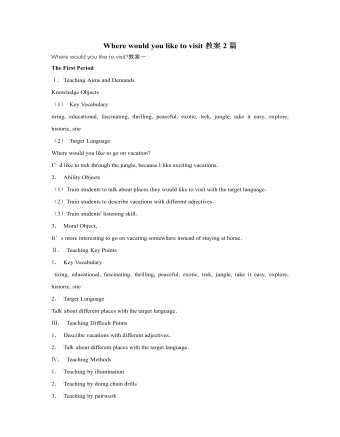
人教版新目标初中英语九年级上册Where would you like to visit教案2篇
The First PeriodⅠ.Teaching Aims and DemandsKnowledge Objects(1) Key Vocabularytiring, educational, fascinating, thrilling, peaceful, exotic, trek, jungle, take it easy, explore, historic, site(2) Target LanguageWhere would you like to go on vacation?I’d like to trek through the jungle, because I like exciting vacations.2. Ability Objects(1)Train students to talk about places they would like to visit with the target language.(2)Train students to describe vacations with different adjectives.(3)Train students' listening skill.3. Moral Object,It′s more interesting to go on vacating somewhere instead of staying at home.Ⅱ. Teaching Key Points1. Key Vocabularytiring, educational, fascinating, thrilling, peaceful, exotic, trek, jungle, take it easy, explore, historic, site2. Target LanguageTalk about different places with the target language.Ⅲ. Teaching Difficult Points1. Describe vacations with different adjectives.2. Talk about different places with the target language.Ⅳ. Teaching Methods1. Teaching by illumination2. Teaching by doing chain drills3. Teaching by pairworkⅤ. Teaching Aids1. A tape recorder2. Some pictures of different places with famous views
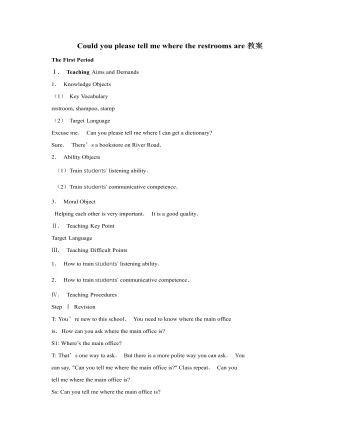
人教版新目标初中英语九年级下册Could you please tell me where the restrooms are教案
Step Ⅰ RevisionCheck homework. Ask a few students to read the article in 3a.Then ask a few students to read their guides.Step Ⅱ Part 1Look at the words in the box. Ask a student to read them. Make sure the students understand the meaning of the words. You are to fill in the blanks with the words. In some cases, students may need to use another form of the word, for example adjusting for tense or subject/ verb agreement.Ask students to fill in the blanks on their own.Check the answers. Step ⅢPart 2Go through the instructions with the class.Look at the example with the students.Ask students what the answer would be.Ask a student to read the question and answer it.Excuse me, could you tell me where the bank is, please?The bank is across the street from the shopping malt.Get students to complete the work in pairs.Check the answers. Ask a few students to read their questions.Step Ⅳ Just for Fun!Ask all the students to read the conversation. Ask: What is funny about this cartoon? Help students to explain. A Martian is a person from the planet Mars.There is no such thing as Martian food on Earth, and the clerk looks silly because he is trying to think of where there is a Martian restaurant.Invite some pairs of students to present this conversation to the rest of the class.Step Ⅴ Summary and HomeworkIn this class, we’ve done much writing practice using the key vocabulary words and the target language presented in this unit. After class, please finish the questions in 2 in your exercise books. Then finish the exercises on pages 47~48 of the workbook as well.The Seventh Period Ⅰ Teaching Aims and Demands1. Knowledge Objects(1) Key Vocabularyimage, adventure, jealousy, hero, crime, journey, brave, no longer, show interest in, take it easy, become interested in, plain looks(2)Text:Grown-ups like cartoons, too.2. Ability Objects(1) Fast-reading to get a general idea of the text.(2) Careful-reading to get the detailed information in the text.
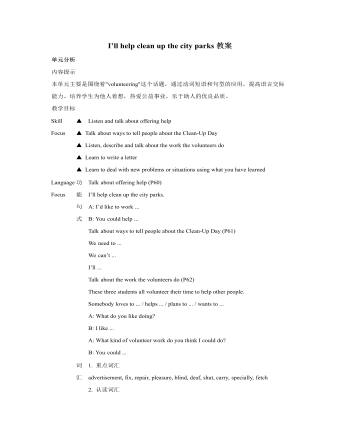
人教版新目标初中英语九年级下册I’ll help clean up the city parks教案
Talk about offering help (P60)I’ll help clean up the city parks.A: I’d like to work ...B: You could help ...Talk about ways to tell people about the Clean-Up Day (P61)We need to ...We can’t ...I’ll ...Talk about the work the volunteers do (P62)These three students all volunteer their time to help other people.Somebody loves to ... / helps ... / plans to ... / wants to ...A: What do you like doing?B: I like ... A: What kind of volunteer work do you think I could do?B: You could ...1. 重点词汇advertisement, fix, repair, pleasure, blind, deaf, shut, carry, specially, fetch2. 认读词汇hunger, homeless, cheer, clean-up, sign, establish, major, commitment, elementary, veterinarian, coach, similar, call-in, strategy, disabled, organization, unable, support, appreciate, donation, part of speech, pronoun, adverb, preposition, conjunction, donate, Jimmy, Sally3. 词组clean up, cheer up, give out, put off, set up, think up, take after, fix up, give away, put up, hand out, work out, at once
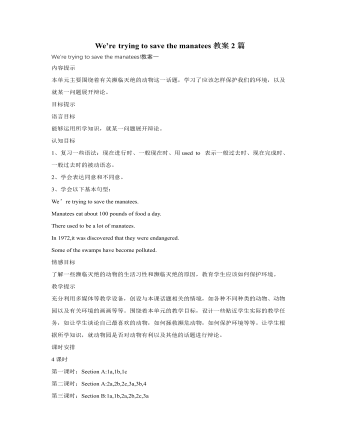
人教版新目标初中英语九年级下册We’re trying to save the manatees教案2篇
本单元主要围绕着有关濒临灭绝的动物这一话题,学习了应该怎样保护我们的环境,以及就某一问题展开辩论。目标提示语言目标能够运用所学知识,就某一问题展开辩论。认知目标1、复习一些语法:现在进行时、一般现在时、用used to 表示一般过去时、现在完成时、一般过去时的被动语态。2、学会表达同意和不同意。3、学会以下基本句型:We’re trying to save the manatees.Manatees eat about 100 pounds of food a day.There used to be a lot of manatees.In 1972,it was discovered that they were endangered.Some of the swamps have become polluted.情感目标了解一些濒临灭绝的动物的生活习性和濒临灭绝的原因,教育学生应该如何保护环境。教学提示充分利用多媒体等教学设备,创设与本课话题相关的情境,如各种不同种类的动物、动物园以及有关环境的画画等等。围绕着本单元的教学目标,设计一些贴近学生实际的教学任务,如让学生谈论自己最喜欢的动物,如何拯救濒危动物,如何保护环境等等。让学生根据所学知识,就动物园是否对动物有利以及其他的话题进行辩论。
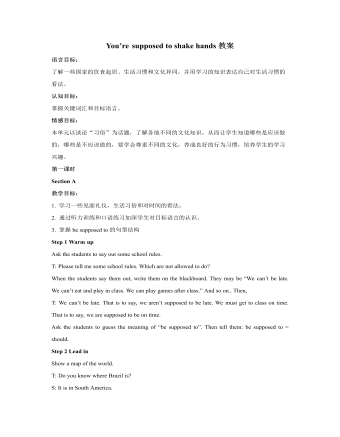
人教版新目标初中英语九年级下册You’re supposed to shake hands教案
教学目标:1. 掌握本单元一些重点词汇的写法和用法。2. 学会自如谈论餐桌礼仪。Step 1 RevisionAsk some students to retell the customs at the table in France in the passage in 3a.Step 2 Self checkPart 1. Fill in each bland with the correct word given. Students do the exercises by themselves at first. Then check the answers. Ask the students to comprehend the sentences and help them point out uses of some words, like “arrive (at / in) sw., spend time / money on sth , spend time / money (in) doing sth.”Part 2. Read about Fan Ling’s experience in a western restaurant. Understand the passage. Point out some key points in the passage.1. be / get used to doing sth. 习惯做某事2. begin with = start with 以….开头3. crowd v. 挤满,塞满 the crowd 人群 crowded adj. 拥挤的Then students discuss about how she would solve her problem. Ask some to share their stories with others.Part 3. Complete the crossword by looking at the sentences on the left. Then check the answers.
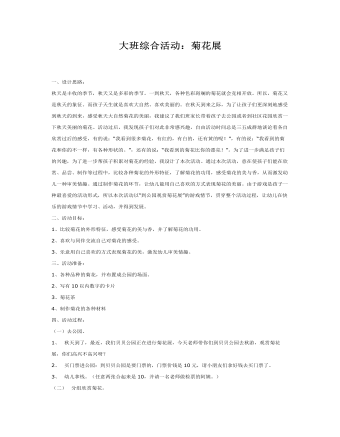
大班综合教案:菊花展
在秋天到来之际,为了让孩子们更深刻地感受到秋天的到来,感受秋天大自然菊花的美丽,我建议了我们班家长带着孩子去公园或者到社区花园欣赏一下秋天美丽的菊花。活动过后,我发现孩子们对此非常感兴趣,自由活动时间总是三五成群地谈论着各自欣赏过后的感受,有的说:“我看到很多菊花,有红的,有白的,还有黄的呢!”,有的说:“我看到的菊花和你的不一样,有各种形状的。”,还有的说:“我看到的菊花比你的漂亮!”。为了进一步满足孩子们的兴趣,为了进一步帮孩子积累对菊花的经验,我设计了本次活动。通过本次活动,意在使孩子们能在欣赏、品尝、制作等过程中,比较各种菊花的外形特征,了解菊花的功用,感受菊花的美与香,从而激发幼儿一种审美情趣。通过制作菊花的环节,让幼儿能用自己喜欢的方式表现菊花的美丽。由于游戏是孩子一种最喜爱的活动形式,所以本次活动以“到公园观赏菊花展”的游戏情节,贯穿整个活动过程,让幼儿在快乐的游戏情节中学习、活动,并得到发展。 二、活动目标: 1、比较菊花的外形特征,感受菊花的美与香,并了解菊花的功用。 2、喜欢与同伴交流自己对菊花的感受。 3、乐意用自己喜欢的方式表现菊花的美,激发幼儿审美情趣。
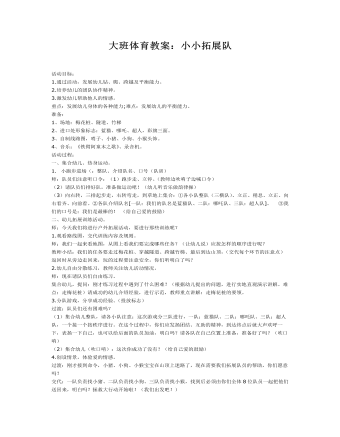
大班体育教案:小小拓展队
2.培养幼儿的团队协作精神。 3.激发幼儿帮助他人的情感。 重点:发展幼儿身体的各种能力;难点:发展幼儿的平衡能力。 准备: 1、场地:梅花桩、隧道、竹梯 2、进口处形象标志:蓝猫、哪吒、超人,彩旗三面。 3、自制线路图,哨子、小猪、小狗、小猴头饰。 4、音乐:《铁臂阿童木之歌》、录音机。 活动过程: 一、集合幼儿、热身运动。 1. 小跑步进场(:整队、介绍队名、口号(队训) 师:队员们注意听口令:(1)跑步走、立停。(教师边吹哨子边喊口令) (2)请队员们排好队,准备做运动吧!(幼儿听音乐做韵律操) (3)向右转,三排起步走,右转弯走,到草地上集合:①各小队整队(三横队)、立正、稍息、立正。向右看齐、向前看。②各队介绍队名[一队:我们的队名是蓝猫队、二队:哪吒队、三队:超人队]。③我们的口号是:我们是最棒的!(给自己爱的鼓励)
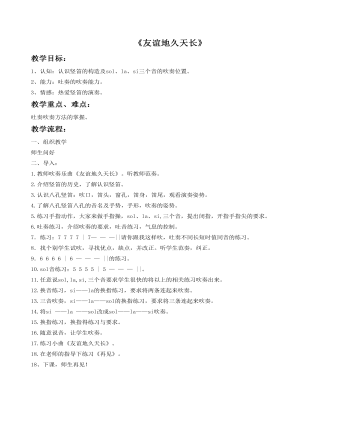
《友谊地久天长》教案
教学流程: 一、组织教学师生问好二、导入:1.教师吹奏乐曲《友谊地久天长》。听教师范奏。2.介绍竖笛的历史,了解认识竖笛。3.认识八孔竖笛:吹口,笛头,窗孔,笛身,笛尾,观看演奏姿势。4.了解八孔竖笛八孔的音名及手势,手形,吹奏的姿势。5.练习手指动作,大家来做手指操,sol、la、si,三个音,提出闭指,开指手指尖的要求。6.吐奏练习,介绍吹奏的要求,吐音练习,气息的控制。7.练习:7 7 7 7 | 7———||请你跟我这样吹,吐奏不同长短时值同音的练习。8.找个别学生试吹,寻找优点,缺点,并改正。听学生范奏,纠正。9.6 6 6 6 | 6 ——— ||的练习。10.sol音练习:5 5 5 5 | 5 ——— ||。11.任意说sol,la,si,三个音要求学生很快的将以上的相关练习吹奏出来。12.换音练习,si——la的换指练习,要求将两条连起来吹奏。13.三音吹奏,si——la——sol的换指练习,要求将三条连起来吹奏。14.将si ——la ——sol改成sol——la——si吹奏。15.换指练习,换指得练习与要求。16.随意说音,让学生吹奏。17.练习小曲《友谊地久天长》。18.在老师的指导下练习《再见》。18、下课,师生再见!
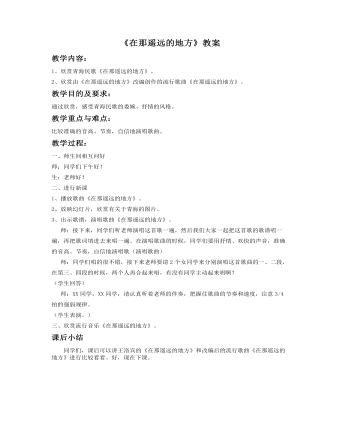
《在那遥远的地方》教案
教学过程:一、师生间相互问好师:同学们下午好!生:老师好!二、进行新课 1、播放歌曲《在那遥远的地方》。2、放映幻灯片,欣赏有关于青海的图片。3、出示歌谱,演唱歌曲《在那遥远的地方》。 师:接下来,同学们听老师演唱这首歌一遍,然后我们大家一起把这首歌的歌谱唱一遍,再把歌词填进去来唱一遍。在演唱歌曲的时候,同学们要用抒情、欢快的声音,准确的音高、节奏,自信地演唱歌(演唱歌曲) 师:同学们唱的很不错,接下来老师要请2个女同学来分别演唱这首歌曲的一、二段,在第三、四段的时候,两个人再合起来唱,有没有同学主动起来唱啊?(学生回答) 师:XX同学,XX同学,请认真听着老师的伴奏,把握住歌曲的节奏和速度,注意3/4拍的强弱规律。(学生表演。)三、欣赏流行音乐《在那遥远的地方》。
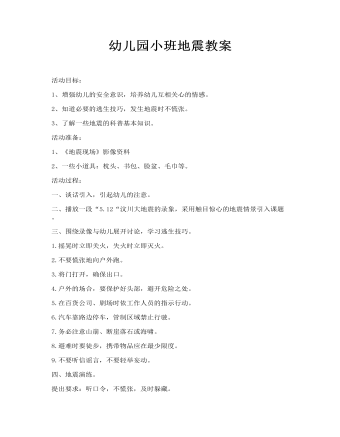
幼儿园小班地震教案
二、播放一段“5.12“汶川大地震的录象,采用触目惊心的地震情景引入课题。三、围绕录像与幼儿展开讨论,学习逃生技巧。1.摇晃时立即关火,失火时立即灭火。2.不要慌张地向户外跑。3.将门打开,确保出口。4.户外的场合,要保护好头部,避开危险之处。5.在百货公司、剧场时依工作人员的指示行动。6.汽车靠路边停车,管制区域禁止行驶。
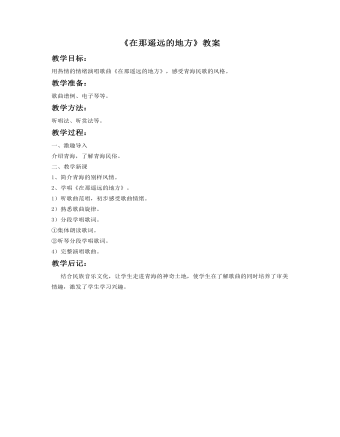
《在那遥远的地方》教案
教学目标:用热情的情绪演唱歌曲《在那遥远的地方》,感受青海民歌的风格。教学准备:歌曲谱例、电子琴等。教学方法:听唱法、听赏法等。教学过程:一、激趣导入介绍青海,了解青海民俗。二、教学新课1、简介青海的别样风情。2、学唱《在那遥远的地方》。 1)听歌曲范唱,初步感受歌曲情绪。2)熟悉歌曲旋律。3)分段学唱歌词。①集体朗读歌词。②听琴分段学唱歌词。4)完整演唱歌曲。教学后记:结合民族音乐文化,让学生走进青海的神奇土地,使学生在了解歌曲的同时培养了审美情趣,激发了学生学习兴趣。
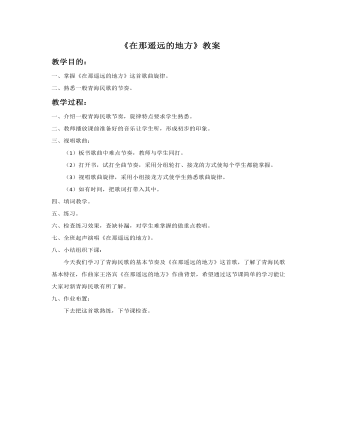
《在那遥远的地方》教案
教学过程:一、介绍一般青海民歌节奏,旋律特点要求学生熟悉。二、教师播放课前准备好的音乐让学生听,形成初步的印象。三、视唱歌曲: (1)板书歌曲中难点节奏,教师与学生同打。 (2)打开书,试打全曲节奏,采用分组轮打、接龙的方式使每个学生都能掌握。 (3)视唱歌曲旋律,采用小组接龙方式使学生熟悉歌曲旋律。 (4)如有时间,把歌词打带入其中。四、填词教学。五、练习。六、检查练习效果,查缺补漏,对学生难掌握的做重点教唱。七、全班起声演唱《在那遥远的地方》。八、小结组织下课: 今天我们学习了青海民歌的基本节奏及《在那遥远的地方》这首歌,了解了青海民歌基本特征,作曲家王洛宾《在那遥远的地方》作曲背景,希望通过这节课简单的学习能让大家对新青海民歌有所了解。九、作业布置: 下去把这首歌熟练,下节课检查。
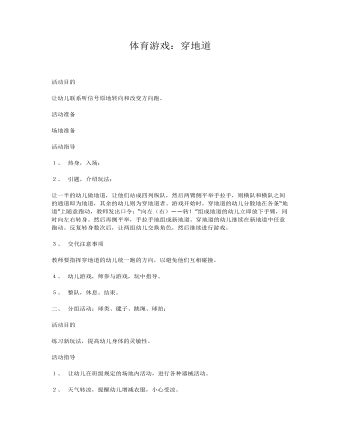
体育游戏:穿地道课件教案
2、 引题,介绍玩法;让一半的幼儿做地道,让他们站成四列纵队,然后两臂侧平举手拉手,则横队和横队之间的通道即为地道,其余的幼儿则为穿地道者。游戏开始时,穿地道的幼儿分散地在各条“地道”上随意跑动,教师发出口令:“向左(右)――转!”组成地道的幼儿立即放下手臂,同时向左右转身。然后再侧平举,手拉手地组成新地道。穿地道的幼儿继续在新地道中任意跑动。反复转身数次后,让两组幼儿交换角色,然后继续进行游戏。3、 交代注意事项教师要指挥穿地道的幼儿统一跑的方向,以避免他们互相碰撞。4、 幼儿游戏,师参与游戏,玩中指导。5、 整队,休息。结束。
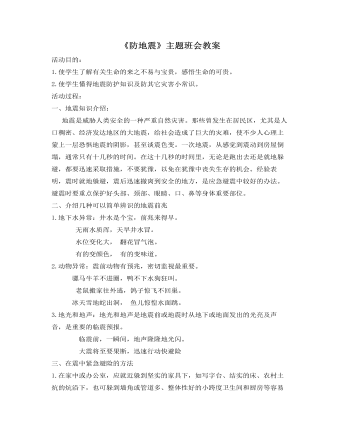
《防地震》主题班会教案
活动目的:1.使学生了解有关生命的来之不易与宝贵,感悟生命的可贵。2.使学生懂得地震防护知识及防其它灾害小常识。活动过程:一、地震知识介绍:地震是威胁人类安全的一种严重自然灾害。那些曾发生在居民区,尤其是人口稠密、经济发达地区的大地震,给社会造成了巨大的灾难,使不少人心理上蒙上一层恐惧地震的阴影,甚至谈震色变。一次地震,从感觉到震动到房屋倒塌,通常只有十几秒的时间。在这十几秒的时间里,无论是跑出去还是就地躲避,都要迅速采取措施,不要犹豫,以免在犹豫中丧失生存的机会。经验表明,震时就地躲避,震后迅速撤离到安全的地方,是应急避震中较好的办法。避震时要重点保护好头部、颈部、眼睛、口、鼻等身体重要部位。
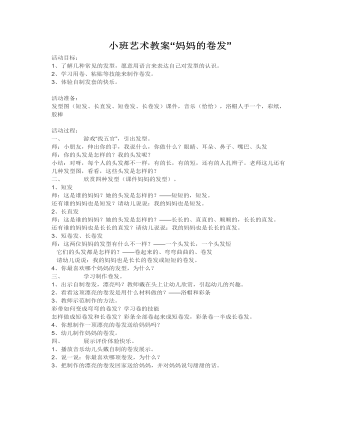
小班艺术教案“妈妈的卷发”
2、学习用卷、粘贴等技能来制作卷发。 3、体验自制发套的快乐。 活动准备: 发型图(短发、长直发、短卷发、长卷发)课件,音乐(恰恰),浴帽人手一个,彩纸,胶棒 活动过程: 一、 游戏“找五官”,引出发型。 师:小朋友,伸出你的手,我说什么,你做什么?眼睛、耳朵、鼻子、嘴巴、头发 师:你的头发是怎样的?我的头发呢? 小结:对呀,每个人的头发都不一样,有的长,有的短,还有的人扎辫子。老师这儿还有几种发型图,看看,这些头发是怎样的?
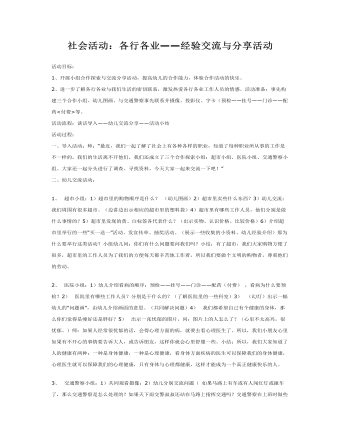
社会活动教案:各行各业
活动流程:谈话导入——幼儿交流分享——活动小结活动过程:一、导入活动:师:“最近,我们一起了解了社会上有各种各样的职业,知道了每种职业所从事的工作是不一样的,我们的生活离不开他们,我们还成立了三个合作探索小组:超市小组、医院小组、交通警察小组。大家还一起分头进行了调查、寻找资料,今天大家一起来交流一下吧!”二、幼儿交流活动:1、 超市小组:1)超市里的购物顺序是什么?(幼儿图画)2)超市里卖些什么东西?3)幼儿交流:我们周围有很多超市。(边讲边出示相应的超市里的塑料袋)4)超市里有哪些工作人员,他们分别是做什么事情的?5)超市里发现的黄、白标签各代表什么?(出示实物、认识价格、比较价格)6)介绍超市里举行的一些“买一送一”活动、发宣传单、抽奖活动。(展示一些收集的小资料、幼儿经验介绍)那为什么要举行这类活动?小组幼儿问:你们有什么问题要问我们吗?小结:有了超市,我们大家购物方便了很多,超市里的工作人员为了我们的方便每天都辛苦地工作着,所以我们要做个文明的购物者,尊重他们的劳动。

